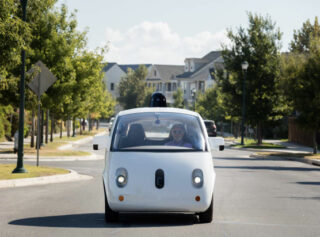
— Caleb Diehl is a staff writer at Oregon Business Magazine. This is his first story for BikePortland.
Despite recent news of an autonomous vehicle crash in Tempe, Arizona, the Oregon Department of Transportation’s task force on autonomous vehicles is driving forward.
The group will hold its first meeting on April 18. Among the 27 members appointed by ODOT Director Matthew Garrett you’ll find members of the trucking, taxicab and automotive industries.
You won’t, however, find anyone from an organization that advocates for biking and walking.
ODOT spokesperson Sarah Kelber said she couldn’t comment on the makeup of the task force, which is outlined in HB 4063, the bill that created it. The language of the legislation doesn’t leave much wiggle room for choosing appointees. But it does mandate that one member come from a nonprofit, which could have opened the door for an advocate of vulnerable road users. The Street Trust’s Advocacy Director Gerik Kransky said his organization was notified too late in the process to take part.

The omission is particularly striking given the recent developments in autonomous vehicle testing. Uber put the brakes on AV testing after March 18, when one of its self-driving cars struck and killed a 49-year-old woman crossing the street in Tempe, Arizona. That marked the first known fatality of someone walking due to an autonomous vehicle. After the incident, Uber suspended testing in Tempe, Pittsburgh, San Francisco and Toronto.
“I can’t imagine it would not come up in conversation. It will continue to come up as we keep safety at the center of what we’re doing.”
— Sarah Kelber, ODOT, referring to the fatal Uber crash
While some states and cities have scaled back, ODOT remains open to testing. The agency says on its website that it’s, “Looking to work with any company that has interest in bringing automated vehicles to Oregon.”
Kelber says the Tempe collision will affect the task force discussions though. “I can’t imagine it would not come up in conversation,” she says. “It will continue to come up as we keep safety at the center of what we’re doing.”
Without an advocate for biking or walking in the room, however, that discussion could trend toward statements like that made by Tempe Police Chief Sylvia Moir, who essentially blamed the victim for her own death by saying she, “came from the shadows right into the roadway.” Video released by Uber showed she was actually three-quarters of the way across the street when the car hit her. The human backup driver who could have slammed the brakes was looking at their lap.
While safety is at the top of the list, other talking points for the ODOT task force include: licensing and registration, insurance and liability, law enforcement and crash reporting, and cybersecurity.
Autonomous vehicles were a key focus of the national Urbanism Next Conference that took place in Portland in early March. Planners and politicians were split on whether widespread adoption of AVs would constitute a heaven or hell scenario. They could alleviate problems for elderly and handicapped people, make traffic flow more efficient, and eliminate the 94 percent of crashes caused by human error.
Or they could provide a big incentive to drive instead of taking other transportation modes, contributing to congestion, sprawl and the myriad other negative externalities of driving.
Daimler has already started testing semi-autonomous trucks on its Eastern Oregon test track, although those vehicles still need a driver behind the wheel.
Four members of the task force still need to be nominated. The President of the Senate will choose a Democrat and a Republican from the Senate, and the Speaker of the House will do the same for the house.
The task force will set out procedural guidelines in the first meeting including how often it will meet. The meetings will be open to the public, and the public can submit written or verbal comment. “Everybody is welcome,” Kelber says, “especially bike and pedestrian related folks to weigh in on what is going on.”
The first meeting, on April 18, will be at 9 a.m. in Room 101 at the Chemeketa Center for Business and Industry (CCBI) in Salem. The task force must present a report to the legislature by September 2018. Learn more on ODOT’s website.
(In related news: On March 28th, the Portland Bureau of Transportation officially authorized an Administrative Rule (TRN-14.34) that establishes a permit system for commercial AVs to operate in Portland.)
— Caleb Diehl
Get this post delivered directly to your inbox.
BikePortland needs your support.



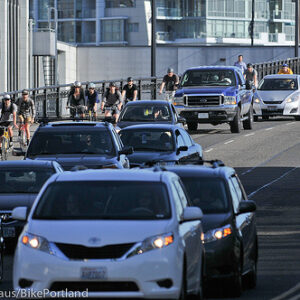
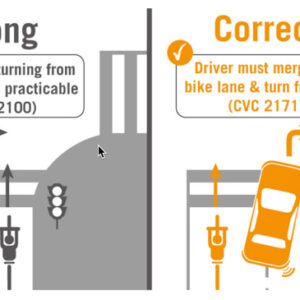
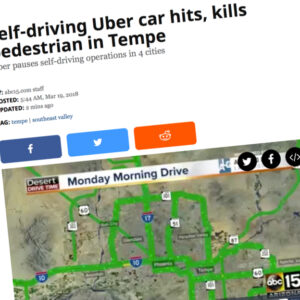
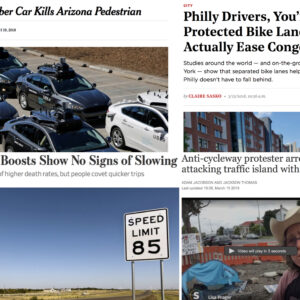
Thanks for reading.
BikePortland has served this community with independent community journalism since 2005. We rely on subscriptions from readers like you to survive. Your financial support is vital in keeping this valuable resource alive and well.
Please subscribe today to strengthen and expand our work.
Uber apparently turned off its Lidar detection equipment, perhaps to see how well their vehicle would perform without this critical hardware in operation. The results were predictably fatal.
This gets to the heart of the matter: AV’s are just about ready for prime time, but the companies putting them on the road aren’t. Thus it will be critical that the states implement very carefully thought-out regulations that prevent the kind of cost-cutting experiments that led to the fatality in Arizona. I’m an optimist with respect to AV’s, but I have serious doubts about anything that Matt Garrett touches ending well.
Prove it was turned off. Sounds like expected propaganda lie.
The latest info is that Uber scaled back the number of Lidar units on its car from 7 to just one. This gave the car huge blind spots relative to the cars equipped with more Lidar detection units. Other AV’s currently use 5 or 6 Lidar units.
The fact that the car did not brake prior to impact is not disputed. The vehicle had a collision braking system and I have seen how this works in a real life situation. So the collision braking system (there are many brand names so I’m choosing to be generic here) either did not detect Ms. Herzberg and her bicycle or it was disabled.
Whatever features an AV has, the base set of features should always include engaging braking when objects appear in front of the vehicle. Many AV implementations disengage this feature over 50 MPH to make highway driving safe because you don’t want false positives causing massive pileups but in this instance, the Uber vehicle was on a local road going 40 MPH so the system should have been engaged.
An obvious goal of the venture-capital- and megacorp-funded AV industry is the creation of an extensive urban road network that is permanently inaccessible to people walking or rolling.
I’m sure that will be the suggested solution to collisions like in AZ — certainly more likely without any walking/biking advocates in the room.
That kind of thinking is even reflected within PBOT. They are proposing safety changes for North Greeley. Unfortunately, these safety improvements include widening 2 lanes to 12′ and 13′ respectively, and shunting the bikes and peds off to the side on an indequate facility with a poor/dangerous connection to Interstate. They say safety is the goal, but moving more cars even faster (median speed is already OVER 55 here!) is what they do.
Jonathan – yes I concur that “the non-profit” representative should have had more of a transportation safety / vulnerable roadway user focus…I am not sure why the author’s of the bill did not work to loop in The Streets Trust or Oregon Walks much earlier in the process. It is a good “placeholder” to have OEC at the table for now…
..though it should only be a placeholder [from what I can see posted on-line]…as Deputy Director Hagerbaumer does have some transportation background on vehicle emissions/ air quality / policy reform…but it may not be enough to deal with the deeper technical issues of human factors / traffic safety / roadway operations that beta AV testing in our public spaces will require unless Oregon wants to turn into Arizona…
“I am not sure why the author’s of the bill did not work to loop in The Streets Trust or Oregon Walks much earlier in the process.”
Carheads? Certainly they’re not regular walkers or riders.
Follow the money welcome to America
Exactly why Uber was testing with reduced safety features.
And to follow up with Arizona’s experience of “managing” the rules for testing of AVs on public streets…its Arizona Self-Driving Vehicle Oversight Committee has only met once “publicly”* versus its original guidelines for quarterly meetings…another 5 to 6 meetings should have happened…not really much public oversight it would seem.
https://www.azdot.gov/about/boards-and-committees/arizona-self-driving-vehicle-oversight-committee
So please Oregon (and Governor Brown) use this as an opportunity to do it right and for full public access / awareness and involvement in this high stakes opportunity…furthermore, the State of Oregon should adopt regulations that any permitted AV being tested in the public ROW should take 100% of the responsibility for collisions and injuries when it comes to vulnerable roadway users.
[*There is a reported second meeting during December 2016 but it was likely without public notification on the committee’s website or even access to the agenda or materials after the fact…as its still not posted on their website two years later.]
Clarification: a staffer of the AZDoT emailed me to say that this “second meeting” occurred on October 11, 2016 and not in December, as they had previously emailed. They said it was a meeting “open to the public” but that it did not need to abide by the state’s open meeting law (provide public minutes etc.) due to its function and the entity that created it.
There has been more press coverage of the outcomes from the Tempe Uber crash / 1st pedestrian killed by an AV. Ray Stern, PHX New Times wrote an interesting article looking into all of the parties involved in the crash:
http://www.phoenixnewtimes.com/news/arizona-governor-doug-ducey-shares-blame-fatal-uber-crash-10319379
Stern’s article included some interesting tidbits too:
“Vasquez, in theory, could be criminally charged in Herzberg’s death even if Uber can prove the vehicle was in autonomous mode.”
“According to Kirk Adams, Ducey’s chief of staff, Uber and other self-driving car companies could be considered people under the law. They could be criminally charged, if warranted, he said.”
“As of March 18, Clark Miller pointed out at a recent panel discussion at ASU, the ratio is now about 10 million miles annually per fatality for self-driving cars. In other words, from the evidence we have so far, the average for self-driving cars is 10 times worse than for human drivers.” {Panel: ASU Case Critical Series: The Future of Autonomous Vehicles 2018/03}
Stern continued:
“The crash highlights how little the public knows about the performance of autonomous vehicles, not to mention how little is known about their performance in Arizona, panel members pointed out.” Panel: ASU Case Critical Series: The Future of Autonomous Vehicles 2018/03/30
“Panelist David King, a professor for ASU’s School of Geoscience and Urban Planning, said he was rattled by the car’s failure. ‘I’m personally less confident in the technology now than I was two weeks ago,” King said. ‘I thought what happened [fatal collision with pedestrian] on Mill Avenue had been solved.’ ”
Andrew Maynard, a professor of risk management at ASU, said “My attitude has changed over the last 10 days,” … “We need to talk about the risks … I really haven’t seen people asking tough questions about what they want this to look like.”
https://sustainability.asu.edu/events/rsvp/case-critical-series-autonomous-vehicles/
This new Oregon AV committee should add a seat for an ethicist…
Of Uber’s effort in the State of Arizona, Mark Harris of the UK Guardian wrote:
“Remarkably, the public appears to have been kept in the dark. Because of Arizona’s regulatory vacuum, neither Uber nor [Governor] Ducey were obliged to inform the public that Uber’s cars would now be driving themselves on public roads. Neither, it seems, did they believe they had an ethical duty to do so.”
“Chhabra wrote to Seiden, saying Uber wanted to give Phoenix police department ‘a heads up’ about the secret program, and asking if he would recommend someone ‘discreet’ to contact.”
“Contacted by the Guardian, Ducey declined to explain why the governor’s office chose to keep the program secret.”
https://www.theguardian.com/technology/2018/mar/28/uber-arizona-secret-self-driving-program-governor-doug-ducey
Instead of using unsuspecting citizens as test guinea pigs without their consent, why don’t the interested tech companies buy land, build private roads and have their CEO’s walk back and forth in front of the self-driving cars to test the technology they will profit from?
Autonomous vehicles are nothing new. Many decades ago excellent robots could travel goodly distances to achieve predictable ends. The end was military–destruction of a target.
In the 1950s the Naval Ordnance Test Station devised the heat-seeking “Sidewinder” air-to-air missile, with the electronic complexity of a (vacuum-tube) portable radio and the mechanical complexity of a washing machine. When Russian engineers captured one they were amazed, calling it “organic,” and toasted its designer, William B. McLean, of Portland, Oregon, via China Lake, California.
Sidewinder worked like this: the airplane’s pilot would listen for a 400 Hz “growl” in his headphones, sign that his faithful hunting dog had sensed a potential victim. With that confirmed, the pilot could release his hound and turn away, the “organic” hunter dispatching its quarry of its own accord with near certainty.
Watching a Sidewinder pursue a target drone was uncanny. “Mind” of its own. All analog all vacuum-tube all washing machine “mind.”
An important distinction: Sidewinder, like its autonomous cousin, the television-guided glide-bomb “Walleye,” was construed to a single, positive, well-defined goal. Within this vital constraint they excelled. The present idea of an autonomous motor vehicle is a much more complex system of positive goals–go from point A to point B by roads X, Y, Z, observing laws 1, 2, 3…–and negative resolutions, especially Isaac Asimov’s first law of robotics–thou shall not cause inconvenience, injury, death to any living being–along the way.
Exclude the idea of Arthur Clarke and Stanley Kubrick that robots can become so paranoid that they decide to extinguish life on purpose.
Digital egomaniacs are so paranoid in pursuit of “autonomy” that they fail to observe the fundamental constraints that laws of nature place upon their obsessions. A robot can defeat a human at chess or go–if allowed to use a million times the electrical power of the human brain. The first law of thermodynamics–conservation of energy–guarantees that no engineer can place sufficient sensing and computing power into a car to equal the performance of a human. The second law of thermodynamics–information as the inverse of disorder–ensures that at a constrained level of power the human brain, the senses and actions it controls, will command superior global results.
So “B. Carfree,” above, is misguided. AVs are not now ready for prime time. Never will they be ready for any fully human task, especially one so ill-defined as operating a motor vehicle.
“AVs are not now ready for prime time. Never will they be ready for any fully human task”
1.4 million people are hit and killed each year by fully human drivers (World Health Organization).
I have written this before, perhaps even here on Bike Portland, that technology companies are giddy with the progress they made solving the lowest hanging fruit problems and they are extrapolating this progress rate to bring their products to market completely ignoring that the remaining 20% of problems will require 80% of the effort. I think this is partly driven by such actions raising venture capital.
I think driver assist automation technologies are not only here but will make driving safer. However, full autonomy has not even been achieved in transportation modes that have much easier environments like rail and sea navigation. There’s no hope for full automation in personal vehicles at this time or the near future and this “Autopilot” feature where the driver has to maintain full attention to the road is more than useless, its dangerous. If I have to maintain full driving attention at all times, then I might as well be DRIVING myself. I don’t want to use a feature that will turn my car into a coffin.
This is a really great first report, Caleb. Thank you.
Maybe they didn’t get the memo that bike riders have a seat at the table that is covered by the bike tax.
If anyone made this AV meeting at 9am in Salem, I’d love to know if ODOT or committee members pointed out that the cute Google driverless car on the first slide of ODOT’s presentation is actually dead, and has been for over a year[1].
That bubble car (the “Firefly”) was famously pulled over for going too slowly (it was programmed to go no more than 25mph) [2]. While surely some great engineering came out of the project, Google also gifted the AV industry a huge PR service by creating this very iconic early impression of AVs as likable (it’s so small it can’t be seen as aggressive, and it even has a “face”) and safe (slow driving ticket: great PR).
These days if you want to see that cute, electric, harmless-looking turtle of a car, you’ll have to go to the museum [3]; Google has switched to minivans.
In the (hopefully near) future, it’d be nice if state efforts would either not lead with images such as that on their cover, or at least caption it appropriately. Suggested alternative: the look of shock on the face of the “safety” “driver” when the robo-car ran down a human [4].
1: https://etfdailynews.com/2016/12/13/the-google-car-is-dead/
2: https://www.theguardian.com/technology/2015/nov/13/google-self-driving-car-pulled-over-driving-too-slowly
3: http://www.computerhistory.org/exhibits/whereto/
4: http://a57.foxnews.com/images.foxnews.com/content/fox-news/us/2018/03/27/uber-disabled-safety-component-in-self-driving-car-before-fatal-crash-company-alleges/_jcr_content/par/featured_image/media-0.img.jpg/931/524/1522165004067.jpg